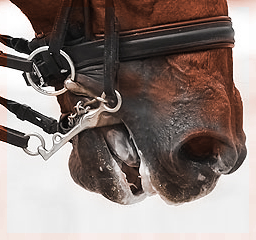Bad banding hurts horses
 Shockwaves are surging through the equestrian world after research found nosebands and double bridles cause unnecessary pain and suffering to horses.
Shockwaves are surging through the equestrian world after research found nosebands and double bridles cause unnecessary pain and suffering to horses.
Researchers from the University of Sydney's Faculty of Veterinary Science say that the restrictive nosebands — which are commonly used in dressage and other events — bind together the jaws of a horse in a way that can prevent yawning, tongue movement and swallowing.
The study’s senior author, Professor Paul McGreevy, said the research shows how restrictive nosebands compromise natural behaviours and trigger a significant stress response in horses, which may violate the International Equestrian Federation’s (FEI) rule that nosebands are ‘never as tightly fixed so as to harm the horse’.
“In light of the current results, horse sport administrators may need to decide which oral behaviours they can afford to see eliminated in the name of sport,” he said.
“Tight nosebands can mask unacceptably rough riding. While wearing a bitted bridle, horses are highly motivated to open their mouths to find comfort but in dressage competitions, this response attracts penalties.”
To avoid such penalties, many riders now crank the jaws together with a system of leather pulleys known as a crank noseband.
This device is permitted under noseband rules, written before cranking was conceived, even though it increases pain and discomfort from the bits.
The pressure from the bands boosts the rider’s control of the horse, which is why they appeal not only to dressage riders but also to show-jumpers and eventers.
But pressure from nosebands often exceeds levels associated in humans with tissue and nerve damage, despite the fact that are padded to avoid cutting into the surface of the skin.
Inside the mouth, they force the cheeks against naturally sharp molars and can lead to lacerations and ulcers.
“The horse’s challenge when managing discomfort from a single bit is magnified if it is required to accommodate two bits, as is common at the elite level in dressage,” said Professor McGreevy.
“For example, every dressage horse at Olympic level must compete with a double bridle which means there are two metal bits in its mouth, one of which is a lever that tightens a metal chain under the chin. The incentive for riders to bind these horses’ jaws together to prevent displays of resistance increases accordingly.”
Many manuals and older rulebooks propose using two fingers as a spacer to guard against over-tightening, but typically fail to specify where these should be placed or the size of the fingers.
The latest research has boosted calls for the routine use of a standardised taper gauge for horse banding.
But Equestrian Australia has denied the finding.
Equestrian Australia's veterinarian Nathan Anthony has told reporters; “We certainly don't see any evidence that crank nosebands are causing any serious injury to horses”.
Dr Anthony poked holes in the study in an interview for the ABC.
“A very small number of horses were tested and looked at,” he said.
“These horses were unconditioned to the use of... a noseband. They'd never had that on before. So, as you'd expect, these horses are likely to have a greater stress response just by virtue of the fact that this is new equipment.”
Lead author Kate Fenner responded to the criticism, saying; “I am not sure that they would ever habituate to something that stops them chewing, licking and pretty much swallowing and can do tissue and nerve damage.”
Ms Fenner said Equestrian Australia; “would have to repeat the study with horses accustomed to wearing them to claim that”.








 Print
Print